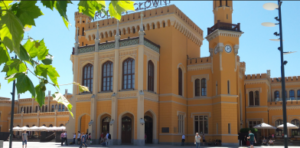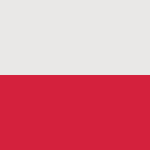5 hours in Wroclaw
#Guide in Wroclaw #Local tour guide in Wroclaw #Private tour guide in Wroclaw #local guide in Wroclaw #tourist guide in Wroclaw
4- 5 hours – price 1,400 zloty for the whole group
We will have for a coffee break on the way
Pick-up at your hotel. The order depends on where you live, but we reach the following elements – and a whole lot more than that:
A building from the days when the railway was important. Built in 1857, it looks almost like a Spanish palace.
On the way to the city centre, we walk along Pilsudski Street, which is lined with mansions from the last century.
At the intersection of Swidnicka Street, we see the installation The Anonymous Predecessor, an ingenious work where pedestrians are absorbed by the ground and emerge on the other side of the street. We’ll talk a bit about the construction of housing under communism.
Here is also the road that leads to the Krzyki neighbourhood, which was totally destroyed during the Russian attack on Wroclaw in 1945 and only rebuilt in modern style in the 1990s.

On the road of Swidnicka Street, part of the city’s old fortification, which was demolished during the Napoleonic Wars.
On the way we also pass a sculpture of a Polish medieval prince, which is part of the story of Worclaw as a Polish city. However, Wroclaw has been Czech and later became German. Poland was simply given a big chunk of Germany after WW2. World War II as a form of compensation for lost territories in the East that were part of the Soviet Union. Poland called these territories the ‘Regained Territories’. We talk a lot about that.
Finally, we pass the opera and the exclusive hotel Monopol, which has been used in several films. It was also from this balcony that Adolf Hitler addressed the people of what was then Breslau.

One of the most impressive town hall squares in Poland, with a town hall from 1504. It is a complex of buildings that were later expanded, remodelled and renovated after war damage.
The rest of Rynek is a patchwork of surviving buildings, modernism, rebuilt houses, fountains, statues and symbols.

Next to the Rynek we find extensions in the form of Salt Square with the old stock exchange and flower vendors.
On the opposite side is the Gothic Maria Magdalena Cathedral from 1523, which we’ll talk a bit about because it was an attempt to build a national Catholic church. It never succeeded in creating a major denomination, but the Polish Catholic Church was supported by the communists in an attempt to create a church that was independent of the Pope.
Another corner is the site of another ancient church.
Breslau was emptied of Germans in 1945, instead the city was renamed Wroclaw, and came to be made up of people who came from the now Soviet territories in the East. Books and documents from the university in the city of Lviv were moved to Wroclaw, which is actually the successor to Lviv University. But the baroque university building from 1739 is anything but Polish.
The Oder River is widely branched at Wroclaw, giving the city a wealth of unique bridges. We’ll take a look at some of the bridges and hear what the river has meant to the city’s history. And then we also hear about flooding.

We spend some time in the market hall, both to see the magnificent architecture, but also to find out what Poles eat and how much it costs.

“Little Vatican” – the word is entirely my own invention. Here you’ll find the huge cathedral, the theological faculty and shops with church equipment. For example, you can buy a Catholic priest dress or a nun’s habit.
Here we talk about the role of the church in Poland – now and in the past. We look at scandals, the church’s influence on society and politics, the church under communism and the Polish Pope John Paul II.
We also see a monument to the Church’s interference in Polish foreign policy during communism with a letter from Polish bishops to German bishops entitled “We forgive and ask for forgiveness”. It was not well received at the Communist Party headquarters.
The Racławicka panorama is a circular cult image from 1893. It depicts the Battle of Racławicka in 1794, where a Polish general rebelled against the Russians and the recent partition of Poland.
We see a model of the fighting and I explain the political meaning and purpose of the image and how it ended up in Wroclaw in 1980.

Here we are again talking about World War II and the agreement between Stalin and Hitler in 1939. We move on to the Katyn massacre and its significance in Polish consciousness. We also talk about the general attitude towards the Soviet Union.
This brings us to the war in Ukraine, Poland’s military and attitudes towards Ukraine. Please note! – There is no clear and unambiguous answer.
Here we come back to WW2. The city became a fortress that could not surrender. I’ll explain a little about how it happened.
We’ll also take a look at some of the impressive architecture on the square.
A long tour of pre-war houses. Some are dilapidated, but most have been refurbished. We can see the war in the buildings, but we can also see that it was once a rich city.
Vi går mod udstillingshallen Hundredeårshallen og slutter vores tur ved zoologisk have. Her besvarer jeg spørgsmål og fortæller lidt om Polen i dag.
Den zoologiske have i Wroclaw er nok Polens mest imponerende ZOO. Særligt deres Afrikarium (dedikeret til det afrikanske kontinent) anses for at være enestående.
Write to me at m@hardenfelt.pl to arrange a guided tour in Wroclaw
